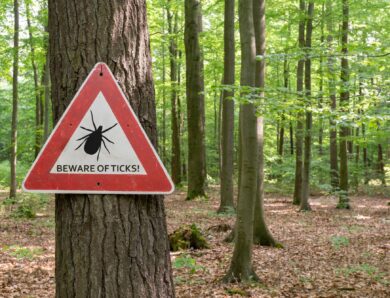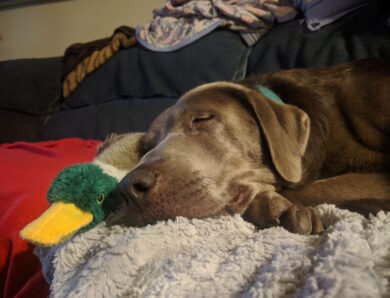
How What Dogs Hear Affects Their Mood
If you’re a dog parent, chances are you’ve experienced that awful helplessness of watching your dog pace or listening to him whine during fireworks or a thunderstorm. The stress-inducing effects of thunder and fireworks are well-known. But what you may not realize is that there are plenty of other noises, many daily occurring, that are causing similar levels of discomfort in your pup.
Keeping It Pawsome chatted with Pet Acoustics CEO and founder Janet Marlow about what dogs hear and how sound influences our dogs’ behaviors. And what we can do to alleviate any problems.
How Sounds Only Dogs Can Hear Influences Their Behavior
Ever noticed your dog get agitated for seemingly no reason at all? Or barking at something you can’t see? It’s likely that she’s hearing something you’re not. Something that’s making her nervous or uncomfortable, and triggering an involuntary fight-or-flight reflex she can’t escape.
A dog’s hearing range is well beyond ours, both in terms of the decibel level of sound and frequency.
“The cutoff point for humans begins the sensitive hearing world of dogs,” Marlow explained. “Like when we go to the window and the dog is barking and we don’t see or hear anything. The dog is saying to us, yes, there is something out there and I am protecting the house.”
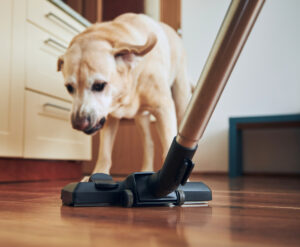
Research, including that pioneered by Marlow, shows that dogs have a comfort hearing level of 60 to 80 decibels. Anything above 80 decibels will hurt your dog’s ears and, as the sound gets louder, can trigger high-stress and alert behavior in your dog.
Without getting into the hard science of how dogs hear (for that you can read Marlow’s “What Dogs Hear“), suffice it to say, the louder the sound or the higher the frequency, the more pressure your dog feels on his inner ear. This is often felt as pain, which can result in a behavioral reaction.
Don’t you cry or get snappy and irritable when you’re in pain?
Remember that the next time you do the laundry and notice your dog moving to an area of the house as far from the washing machine as possible.
Need help with behavioral problems? Learn how to pick a dog trainer.
What Dogs Hear, As It Relates to Hypervigilance
Another possible result of loud and/or high-frequency sounds is hypervigilance. Your dog hears something that he thinks may be a threat, so he continues to listen for it and expect the worst.
That’s a lot of stress for a dog to handle. Especially over a long period of time.
For instance, if you live in an apartment and you’re out for the day, your dog may be hearing the elevator ding and the doors open multiple times a day. Maybe he’s anticipating you coming home? Or he wants to protect against intruders.
If you’re gone all day, that could be eight or more hours of your dog stuck in hypervigilance.
(Symptoms of hypervigilance for those who don’t know include trembling, hiding, barking, whining, and excessive salivation.)
Thunder & Fireworks, the Classic Worst Offenders
According to Marlow’s book, “What Dogs Hear,” the decibel range of sound during a thunderstorm is between 100 and 115 decibels. Well, well into the frequency range that triggers anxiety in dogs.
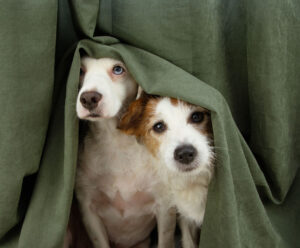
Furthermore, thunder also falls into an infrasonic range that can be picked up by dogs. And cause physical discomfort that Marlow describes as a “pulsating sensation” in their ears.
Fireworks are even worse, with a decibel range of 150 to 175.
Both sounds activate our dogs’ fight-or-flight reflex. Most commonly, this manifests as a need to escape. And, when they can’t, can lead to anxiety and fear.
Other Sounds with A Frequency That Will Hurt a Dog’s Ears
Thunder and fireworks are not the only noises that can stress out our dogs.
Gunfire is another one. Most hunters have to put their dogs through training to desensitize their dogs to the noise.
Music, especially when there’s a heavy base beat involved, is another common — but less recognized — source of agitation for dogs.
Even the tone of your voice can make a difference. While not related to the decibel level of your voice, dogs naturally respond more positively to high-pitched talk (ie baby talk) than they do to regular speech. This can be particularly noticeable in how some dogs react — or, more accurately, don’t react — when a man is speaking to them.
How to Control the Sound in Your Dog’s World
Step One: Test Your Dog’s Noise Environment
To reduce problematic noises in your dog’s world, you first need to identify it. The easiest way to do this is to download a free decibel reader app onto your phone. Marlow recommends dBMeter but there are others.
Then, start exploring your home with the app. Put on the TV and see what happens. Run the dishwasher or a laundry.
Use the app to see what your voice registers at when you’re yelling at the kids or cheering on your favorite football team.
Use it during walks.
Step Two: Accustom Your Dog to Loud Sounds
Loud sounds are part of life. Thunder, the roar of a car without a muffler, a dish falling and breaking. To help your dog be less reactive to loud noises you can try to desensitize them at an early age.
In her book, Marlow suggests using bubble wrap.
"First, use your Decibel App to test the loudness of the pop yourself. Have your dog smell the sheet of bubble wrap to know where the sound is coming from. Then, keeping a distance from your dog in the room, pop one bubble and stop, then say 'It's okay.' During another session pop two bubbles and repeat saying 'It's okay.' Evaluate your pup's response to see if it lessens reactive behavior as you increase the experience… Your reassurance by saying 'It's okay' will be good practice for when you and your dog are on the street and there's a loud pop sound that may startle your dog."
Bringing a new puppy into your home? Get the Ultimate New Puppy Checklist.
Step Three: Reduce Where Possible
As you get a sense of what your dog is hearing, you can begin to think about how to make alterations.
Putting a blanket on a washing machine can mute the sounds it makes. Oiling squeaky doors can eliminate disturbances.
Do you keep your surround-sound speakers on the floor? Consider mounting them on the walls instead, so they’re up higher than your dog’s direct level of hearing.
Do you leave the TV on for your dogs when you leave the house?
What you might not realize is that commercials are purposely designed to be significantly louder than the programs we watch. (You can use your new decibel app to confirm this!)
By leaving the TV, your dog is exposed to frequent intervals of loud sounds he may find disturbing. Making it difficult or even impossible for him to reach a long-term level of relaxation.
The radio might be a better choice.
Again, use your decibel reader to test to ensure the station you choose won’t be a problem.
Step Four: Masking or Redirecting
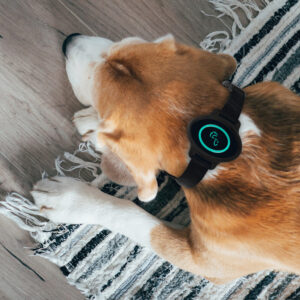
Redirecting your dog’s attention to calming music and masking disturbing or high-decibel noise are the best ways to help your noise-reactive dog, particularly during a long sound event, like a thunderstorm. Or even a party with loud music. For this, you’ll need something like Marlow’s Pet Acoustics Pet Tunes or Ultra Calmer Collar devices.
Both are essentially mini-radios for your dog. They come loaded with sounds and music that have been composed with the frequency and decibel hearing range of dogs in mind. (This type of music is referred to as species specific.) The music avoids anything above a dog’s comfort level and focuses solely on instruments that are soothing to dogs.
Species-specific music provides a “sonic world that allows the animal to release muscle tension without having to perk up their ears,” Marlow explained to Keeping It Pawsome. It avoids the need for dogs to stay alert, listening for what’s next. It allows them to relax.
Pet Tunes is designed for daily use and dogs with average noise reactivity. The Ultra Calmer Collar is designed to mitigate anxiety during high-stress noise events or for dogs with noise phobias.
(Check out this video of Pet Tunes in action in a dog shelter to see how quickly an agitated dog can go from high-stress to at ease.)
For more about what and how dogs hear, and how you can incorporate this into your daily life with your dogs, check out “What Dogs Hear.” Available on Amazon.
Check out these Dog Instagram Accounts You Should Be Following

